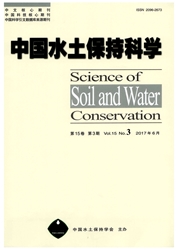

 中文摘要:
中文摘要:
为研究黄土高原丘陵沟壑区不同植被恢复方式下的土壤水分特征,以天水典型对比小流域——桥子西沟(自然恢复的荒草地)和桥子东沟(人工恢复的刺槐林地)为例,基于2流域5—8月0~100 cm深度土壤质量含水量和氢氧同位素浓度,定量分析不同植被恢复方式下降水和坡向对土壤水分影响。结果表明:以刺槐林地为主的流域土壤含水量低于以荒草地为主的流域(16.72%)约3.70%,对降水量的响应较弱,各土层含水量变异系数较高。土壤水分存在临界变化深度,刺槐林地为主的流域在10 cm以下含水量趋于稳定,最大蒸发深度为55 cm,荒草地为主的流域在30 cm以下含水量开始增加,最大蒸发深度为30 cm。两流域含水量均遵循阴坡〉半阴坡〉半阳坡,δ18O的分布不符合这一规律。以刺槐林地为主的流域含水量随坡向变化较小,而以荒草地为主的流域受坡向影响较大,坡向对土壤水分的影响受植被因子的制约。以自然恢复荒草地为主的恢复方式可以较好的增加土壤水库蓄水量,有利于流域生态的可持续发展。
 英文摘要:
英文摘要:
[Background] The hilly and gully region of the Loess Plateau,which is suffering from lacking in water resources,is the most serious soil erosion region in Loess Plateau.Generally,the soil moisture is an effective indicator to evaluate the influence of soil and water conservation measures.The objectives of this paper were to study the redistribution process of precipitation and the effect on the stability of soil reservoir under different modes of vegetation recovery.[Methods]Based on paired watersheds,the effect of precipitation and slope aspect on soil moisture were quantitatively analyzed under different modes of vegetation restoration.Paired watersheds included two typical small watersheds in the hilly and gully regions of Loess Plateau:Qiaozi West Watershed(waste-grassland of natural restoration)and the Qiaozi East Watershed(black locust forestland of artificial restoration).Samples were collected at 9 soil layers in the upstream,midstream and downstream of two paired watersheds.The 9 soil depths were 0-2,2-4,5-15,15-25,25-35,35-45,45-65,65-85,and 85-100 cm,respectively.This project was carried out about 4 times throughout the period from May to August.Characteristics of soil mass water content and isotope concentration of hydrogen and oxygen(δ18O) within0-100 cm soil layer were calculated.[Results] The results showed that there were significant differences in the redistribution of soil water under different vegetation restoration modes(P 0.05).Soil water content of watershed mainly comprising of black locust forestland(16.72%) is lower than that of the watershed mainly comprising of waste-grassland(20.42%).The variation coefficient of soil water content was relatively higher and the response of soil water content to precipitation was weaker in the former watershed.Critical depth for soil moisture was identified for the two watersheds.The water content was relatively stable(about 12.19%) under the soil depth about 10 cm in the black locust forestland.However,the water content in
 同期刊论文项目
同期刊论文项目
 同项目期刊论文
同项目期刊论文
 期刊信息
期刊信息
